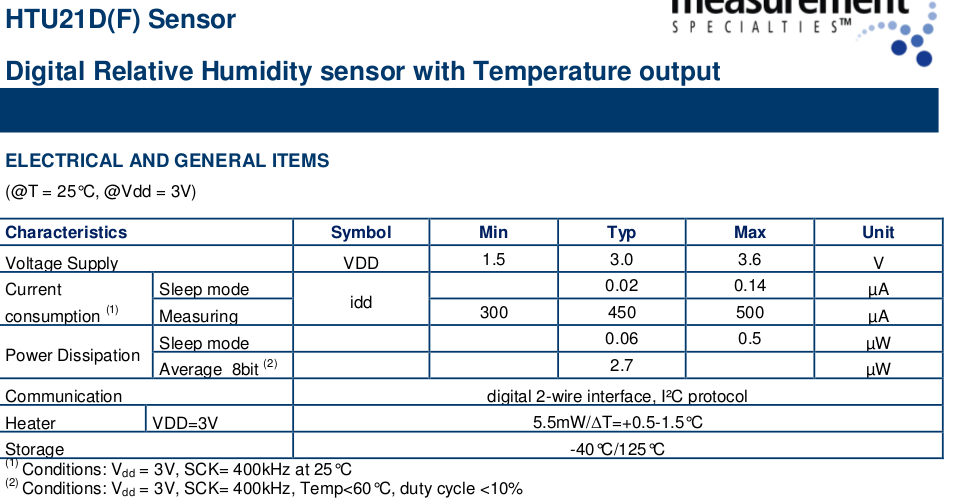Battery powered sensor last 1 week
-
@Martin-Tellblom , I'm in this mess as well. Just ordered a new Multimeter off aliexpress :)
@sundberg84 , have you tried other batteries? I bough some ultrafire 3.7V 8800mAh and will try these.
They were cheap so no loss if they do not work out.. -
@sundberg84 said:
to HIGH to power the sensor and then LOW before you sleep the node.
If you have a multimeter
Alright so if I connect the Vcc sron the sensor to D2 (since I use D3 for measurement) and set that HIGH before I measure, should I have a sleep for it to power up aswell?
Something Like this?
digitalWrite(SOIL_POWER_PIN , HIGH); delayMicroseconds(25); moisture = analogRead(SOIL_SENSE_PIN); delayMicroseconds(25); digitalWrite(SOIL_POWER_PIN , LOW);@Martin-Tellblom said:
Alright so if I connect the Vcc sron the sensor to D2
Hello, you should use another digital pin than D2 as it is used by MySensors library and on the EastPCB it is connected to the INT pin of the NRF24. I had problems using D2 pin before because of this reason. Use D4,5,6,7 or 8 and you will be sure to have no problem.
-
@Martin-Tellblom , I'm in this mess as well. Just ordered a new Multimeter off aliexpress :)
@sundberg84 , have you tried other batteries? I bough some ultrafire 3.7V 8800mAh and will try these.
They were cheap so no loss if they do not work out..@Nicklas-Starkel - Nope I have not, but @AWI has experienced with some other batteries and i know he recommends some sort to be able to avoid the booster.
-
Alright, my sensor has used 5% battery in 124,5 hrs that means that 100% is almost 104 days. Don't know how low the battery works but let say 20% at that is 83 days.
I will start another test with D4 and see how that goes .....
-
@Martin-Tellblom said:
Alright so if I connect the Vcc sron the sensor to D2
Hello, you should use another digital pin than D2 as it is used by MySensors library and on the EastPCB it is connected to the INT pin of the NRF24. I had problems using D2 pin before because of this reason. Use D4,5,6,7 or 8 and you will be sure to have no problem.
@Nca78 - good! And i have this fixed with a jumper in the upcoming rev 9 of EasyPCB as well so it will be possible to use D2.
-
@Martin-Tellblom , how is your project going!
Did you manage to get longer lasting nodes?I have one reed magnetic switch. It seems this only draws 7-10ua in sleep mode and upwards 17ma when sending.
However, it still drains my batteries very quick which I find odd.
It wakes up once every hour to send and that should not be much..
Could be that my rechargable battery is bad so I'll try to replace it with 2AA instead of one 3,7v. -
@Martin-Tellblom , how is your project going!
Did you manage to get longer lasting nodes?I have one reed magnetic switch. It seems this only draws 7-10ua in sleep mode and upwards 17ma when sending.
However, it still drains my batteries very quick which I find odd.
It wakes up once every hour to send and that should not be much..
Could be that my rechargable battery is bad so I'll try to replace it with 2AA instead of one 3,7v.@Nicklas-Starkel
I did not with the Soil Moisture sensor. I choose the easy way to use the Xiaomi Mi plant sensor that I check with BlueTooth instead.But I did succeed with a DHT22 sensor that now have been running 32 days and sending every hour with battery level of 98% now so that one is a success.
-
The DHT22 sensor will also quickly use all your battery power
Replace your NRF24L01+ module, I have had a few that consume too much power, and drain the battery...@bjacobse @Martin-Tellblom I have DHT22 sensor lasting 1.5year, no worries but there are better options! (Both battery and for how good the can measure).
-
@bjacobse @Martin-Tellblom I have DHT22 sensor lasting 1.5year, no worries but there are better options! (Both battery and for how good the can measure).
@sundberg84
Can I assume that you are using power to DHT22 via a FET or directly from Arduino pin, so you are controlling when the DHT22 is getting power/voltage?
I personally think using a DHT22 that requires min 3.3 V is not a good option for battery device - but I understand it can be managed ;-)http://www.datasheetcafe.com/dht22-datasheet-pdf/
DHT22:

My opinion is is use HTU21D instead since it can operate on a much lower battery voltage. Watch out, some breakout boards have a 3,3V voltage regulator, that is just using battery consumption and isn't needed when using Arduino 3.3V 1Mhz battery operated

